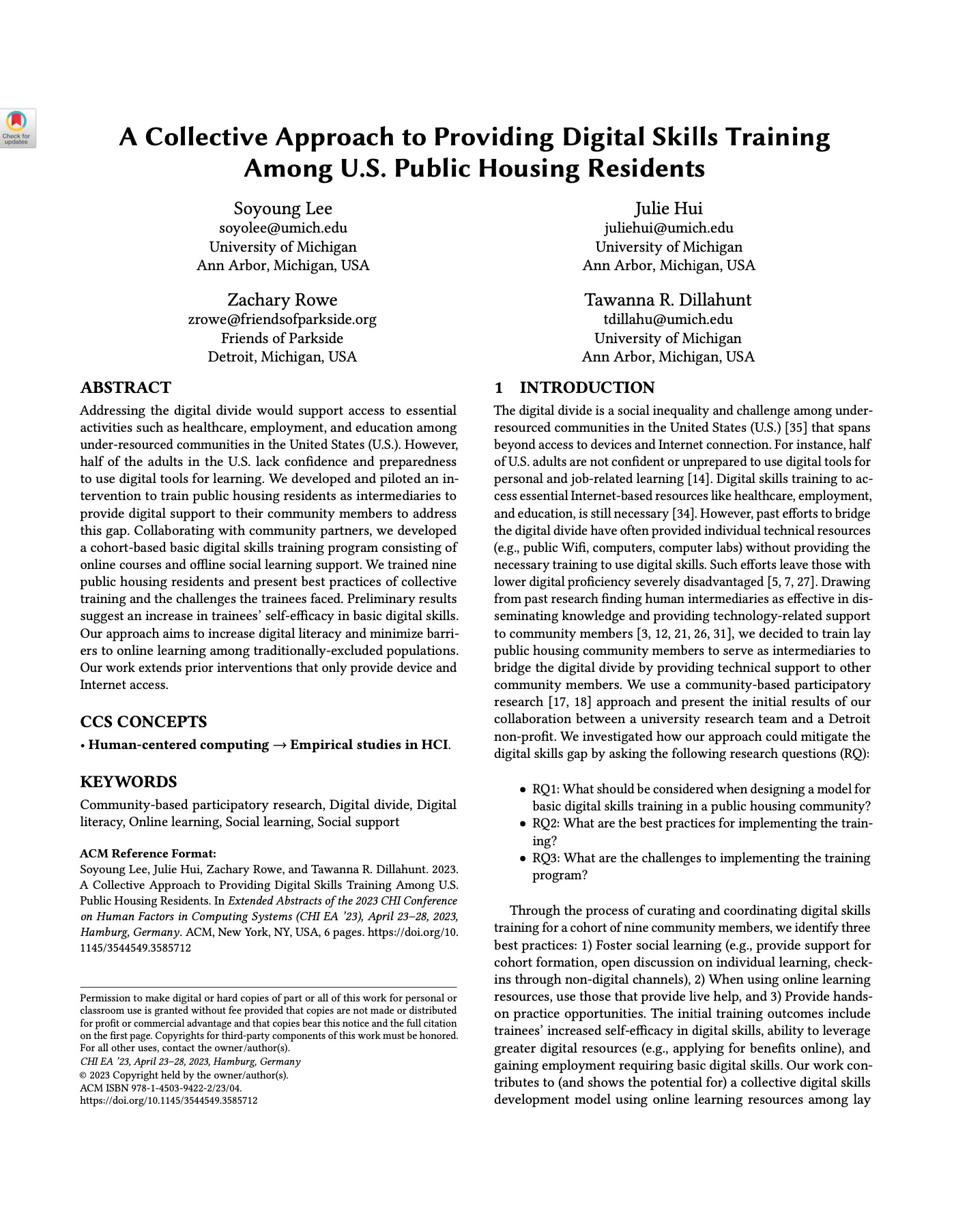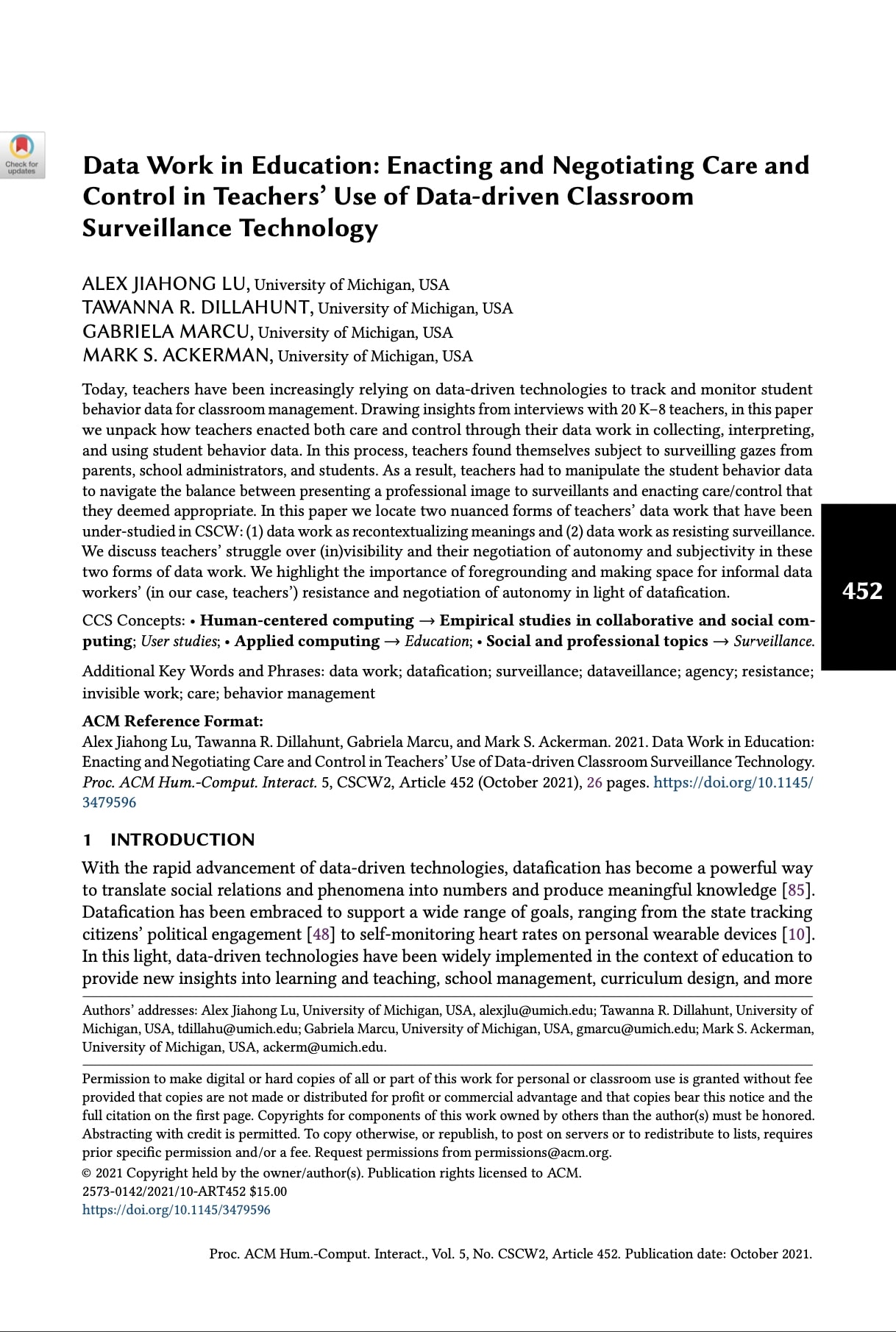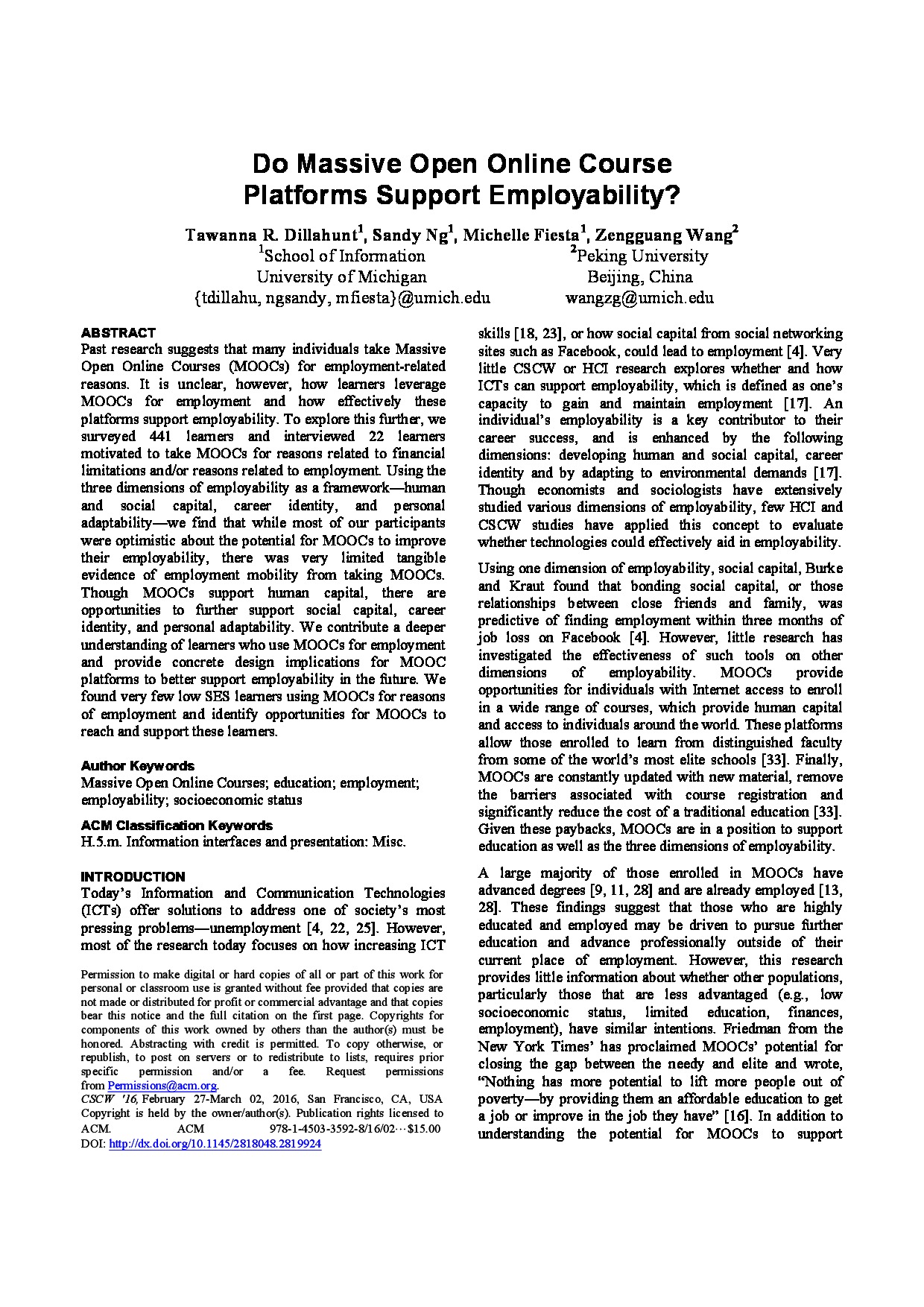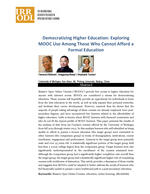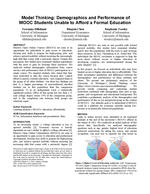
Education
In this project, we explore existing data from Massive Open Online Courses (MOOCs) at the University of Michigan to understand how individuals unable to afford a formal education perform in these courses as compared to those able to afford formal education. I plan to extend the results of the quantitative data and conduct semi-structured interviews to understand if and how MOOCs are being used to increase employment opportunities.
Click here for related videoSubprojects
-
A Collective Approach to Providing Digital Skills Training Among US Public Housing Residents
Lee, S., Hui, J.,Rowe, Z.,Dillahunt, T.R.
Addressing the digital divide would support access to essential activities such as healthcare, employment, and education among under-resourced communities in the United States (U.S.). However, half of the adults in the U.S. lack confidence and preparedness to use digital tools for learning. We developed and piloted an intervention to train public housing residents as intermediaries to provide digital support to their community members to address this gap. Collaborating with community partners, we developed a cohort-based basic digital skills training program consisting of online courses and offline social learning support. We trained nine public housing residents and present best practices of collective training and the challenges the trainees faced. Preliminary results suggest an increase in trainees’ self-efficacy in basic digital skills. Our approach aims to increase digital literacy and minimize barriers to online learning among traditionally-excluded populations. Our work extends prior interventions that only provide device and Internet access. -
Data work in education: Enacting and negotiating care and control in teachers' use of data-driven classroom surveillance technology
Lu, A.J., Dillahunt, T.R., Marcu, G., and Ackerman, M.S.
Today, teachers have been increasingly relying on data-driven technologies to track and monitor student behavior data for classroom management. Drawing insights from interviews with 20 K–8 teachers, in this paper we unpack how teachers enacted both care and control through their data work in collecting, interpreting, and using student behavior data. In this process, teachers found themselves subject to surveilling gazes from parents, school administrators, and students. As a result, teachers had to manipulate the student behavior data to navigate the balance between presenting a professional image to surveillants and enacting care/control that they deemed appropriate. In this paper we locate two nuanced forms of teachers’ data work that have been under-studied in CSCW: (1) data work as recontextualizing meanings and (2) data work as resisting surveillance. We discuss teachers’ struggle over (in)visibility and their negotiation of autonomy and subjectivity in these two forms of data work. We highlight the importance of foregrounding and making space for informal data workers’ (in our case, teachers’) resistance and negotiation of autonomy in light of datafication. -
Do Massive Open Online Course Platforms Support Employability?
Tawanna Dillahunt, Sandy Ng, Michelle Fiesta, Brian (Zengguang) Wang
Past research suggests that many individuals take Massive Open Online Courses (MOOCs) for employment-related reasons. It is unclear, however, how learners leverage MOOCs for employment and how effectively these platforms support employability. To explore this further, we surveyed 441 learners and interviewed 22 learners motivated to take MOOCs for reasons related to financial limitations and/or reasons related to employment. Using the three dimensions of employability as a framework—human and social capital, career identity, and personal adaptability—we find that while most of our participants were optimistic about the potential for MOOCs to improve their employability, there was very limited tangible evidence of employment mobility from taking MOOCs. Though MOOCs support human capital, there are opportunities to further support social capital, career identity, and personal adaptability. We contribute a deeper understanding of learners who use MOOCs for employment and provide concrete design implications for MOOC platforms to better support employability in the future. We found very few low SES learners using MOOCs for reasons of employment and identify opportunities for MOOCs to reach and support these learners. -
Democratizing Higher Education: Exploring MOOC Use Among Those Who Cannot Afford a Formal Education
Tawanna Dillahunt, Brian (Zengguang) Wang, Stephanie Teasley
This paper presents the results of the analysis of data from six Coursera courses offered by the University of Michigan from fall 2012 through winter 2013. In this analysis learners who self-identified as being unable to afford to pursue a formal education (the target group) were contrasted to other learners (the comparison group) in terms of demographics, motivations, course enrollment, engagement and performance. Learners in the target group were primarily male and over 25 years old. A statistically significant portion of the target group held less than a 4-year college degree than the comparison group. Target learners were also significantly underrepresented in the enrollment of the courses examined here. Although the comparison group had a significantly higher completion rate overall than the target group, the target group had a statistically significant higher rate of completing courses with certificates of distinction. This article provides a discussion of these results and suggests how MOOCs could be adapted to better address the needs of learners who feel financially unable to pursue a more traditional path to a post-secondary education. -
Model Thinking: Demographics and Performance of MOOC Students Unable to Afford a Formal Education
Tawanna Dillahunt, Bin Chen, Stephanie Teasley
Massive Open Online Courses (MOOCs) are seen as an opportunity for individuals to gain access to education, develop new skills to prepare for high-paying jobs, and achieve upward mobility without incurring the increasingly high debt that comes with a university degree. Despite this perception, few studies have examined whether populations with the most to gain do leverage these resources. We analyzed student demographic information from course surveys and performance data of MOOC participation in a single course. We targeted students who stated that they were motivated to take the course because they “cannot afford to pursue a formal education,” and compared them to the group of all other students. Our three key findings are that 1) a higher percentage of non-traditional enrolled students are in this population than the comparison population, 2) in an independent t-test, a statistically significant portion (28%) of this group has less than a 4- year college degree versus 15% of the comparison group, and 3) the completion rate between both groups are relatively equal.
